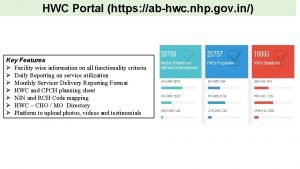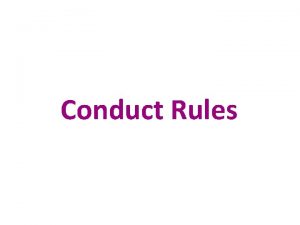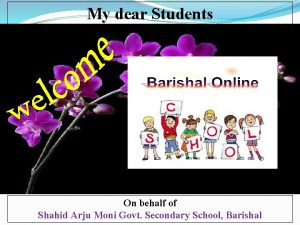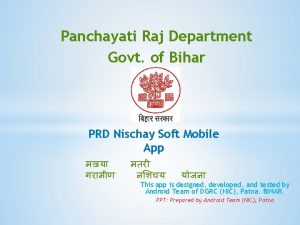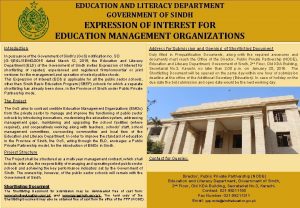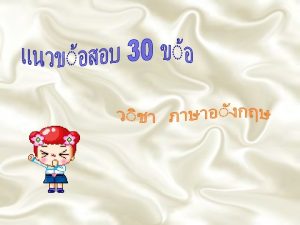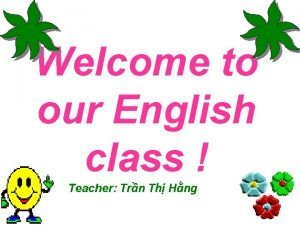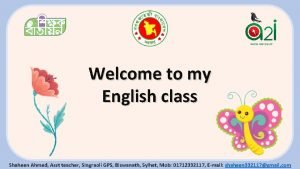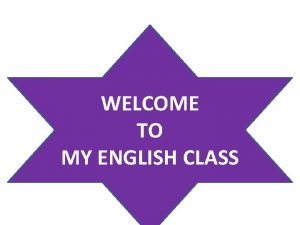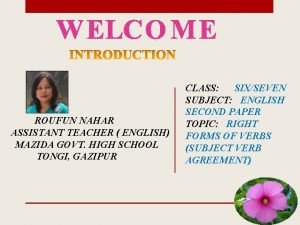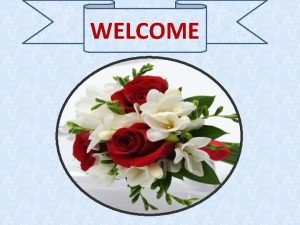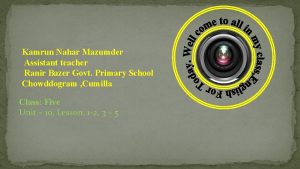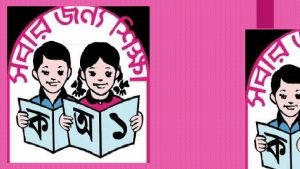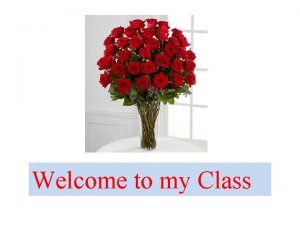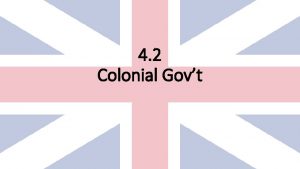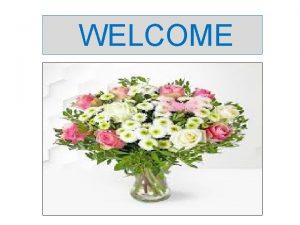Welcome ROUFUN NAHAR ASSISTANT TEACHER ENGLISH MAZIDA GOVT
























- Slides: 24

Welcome

ROUFUN NAHAR ASSISTANT TEACHER ( ENGLISH) MAZIDA GOVT. HIGH SCHOOL TONGI, GAZIPUR CLASS: SEVEN SUBJECT: ENGLISH FIRST PAPER

What do you see in the picture? A Happy family

Today our topic Paul and his family UNIT: Eight LESSON: 7

LEARNING OUTCOMES OF THE LESSON By the end of the lesson the students will be able to • • Read and understand text. make questions and answers about likes/dislikes. Complete guided and semi-guided writing task. Infer the meaning of some key words from the inference.

Feed Meaning Vocabulary To give food to a person or an animal. She feeds the ducks everyday.

Vocabulary Rabbit Meaning a plant-eating mammal with long ears, long hind legs, and a short tail. The rabbit is sitting.

Vocabulary Run around Meaning Run all sides. The man is running around the track.

Insects Meaning Vocabulary A type of small creatures having six legs and a body divided into three parts. Insects usually also have wings. All these are called insects.

Bush Meaning Vocabulary A plant that grows thickly with several stems coming up from the roots; a shrub The children should not go to the bush.

Go to the textbook , section A and read the text and fill the table below. Use the words likes/doesn’t like/loves/hates appropriately under each member of Paul’s family. One is done for you. Thing/activity Paul Sister Mother Father likes Making sandwiches Watching animals loves Spiders hates Cooking Flies loves hates doesn’t like

See the jumble words. Rearrange the words and make question from the box 1 and answer from the box 2. 1. she/ like /drawing/ does /picture/ a/? 2. likes / she /drawing/ yes, /a/ picture/. Q: Does she like drawing a picture? A: Yes, she likes drawing a picture.

See the jumble words. Rearrange the words and make question from the box 3 and answer from the box 4. 3. you/ waste/ like /throwing/ do / here and there /? 4. don’t / I /like /throwing/ no, /waste/ here and there. Q: Do you like throwing waste here and there? A: No, I don’t like throwing waste here and there.

See the jumble words. Rearrange the words and make question from the box 5 and answer from the box 6. 5. she/ like /herself/decorating/ does /flower/ a/with/? 6. loves / she /decorating/ yes, /a/ flower/with/herself. Q: Does she like decorating herself with a flower? A: Yes, she loves decorating herself with a flower.

See the jumble words. Rearrange the words and make question from the box 7 and answer from the box 8. 7. he/ like /in/working/ does /factory/ a/? 8. hates / he /working/ no, /a/ factory/in/. Q: Does he like working in a factory? A: No, he hates working in a factory.

Use the clues to make questions and answers about likes/dislikes. 2. They go to school. 2. picture. Q: She ( likedraws ) ……………? AQ: : ( (like) Yes, like ) ………… Does she like drawing a picture? A: (Yes, like) Yes, she likes drawing a picture. Q: Do they like going to school? A: Yes, they like going to school. Remove See the example:

Use the clues to make questions and answers about likes/dislikes. 2. She studies in load-shedding. Q: ( like ) ………………? A: ( No, not like ) ………… Q: Does she like studying in load-shedding? A: No, she does not like studying in load-shedding.

Use the clues to write questions and answers about likes/dislikes. 1. They make garden. Q: ( like ) ………………? A: ( Yes, love ) …………… Q: Do they like making garden? A: Yes, they love making garden.

Use the clues to write questions and answers about likes/dislikes. 1. The boy pulls garbage. Q: ( like ) ………………? A: ( No, hate ) …………… Q: Does the boy like pulling garbage? A: No, the boy hates pulling garbage.

Look at the structure of making question and answer. Q: Does she like drawing a picture? Q: Do you like throwing waste here and there? 1. Structure of Question: Do/Does + Subject + like + verb + ing + others + ? A: Yes, she likes drawing a picture. A: No, I don’t like throwing waste here and there. 2. Structure of Answer: Yes, /No, + Subject + like/likes/don’t like/doesn’t like/loves/hates +verb + ing + others.

Look at the grid below. It shows the likes and dislikes of two people. Now write sentences about what Sumaiya likes and doesn’t like. One is done for you. Yamim Sumaiya Listen to music Read story books Draw pictures Take exercise 1. Yamin likes listening to music and reading story books but he doesn’t like taking exercise or drawing pictures.

Home Work Write about what you like and don’t like. (Not more than 10 lines)

Acknowledgement Mo. E, DSHE, NCTB & A 2 I respective of officials And the editors panel: Ranjit Poddar, Associate Professor (English) TTC, Dhaka, Md. Jahangir Hasan (English), Assistant Professor TTC, Rangpur and Urmila Khaled Assistant Professor (English) TTC, Dhaka. Their direction, valuable suggestions and intensive supervision have enriched the model contents.

Love and respect your family. Take care of each member’s likes and dislikes.
 Dr. kamrun nahar
Dr. kamrun nahar Khairun nahar
Khairun nahar World map suez canal
World map suez canal Mo portal ncd
Mo portal ncd Http://mdm.mp.gov.in
Http://mdm.mp.gov.in Odisha conduct rules 1959
Odisha conduct rules 1959 Dcideo
Dcideo Shahid arju moni secondary barisal
Shahid arju moni secondary barisal What is b
What is b Prdnischaysoft.bih.nic.in
Prdnischaysoft.bih.nic.in Khagaria college of engineering
Khagaria college of engineering Govt bilasa college bilaspur
Govt bilasa college bilaspur Education and literacy department sindh
Education and literacy department sindh Good morning madam said the students to the teacher
Good morning madam said the students to the teacher Assistant teacher of gps
Assistant teacher of gps Welcome welcome this is our christmas story
Welcome welcome this is our christmas story Decs order no. 59 s. 2000
Decs order no. 59 s. 2000 Good afternoon teacher.
Good afternoon teacher. How to welcome tourist
How to welcome tourist Image of welcome to english class
Image of welcome to english class Welcom to english class
Welcom to english class Welcome to our english class
Welcome to our english class Welcome to our english class
Welcome to our english class Welcome to my english class
Welcome to my english class Welcome to my english class
Welcome to my english class



